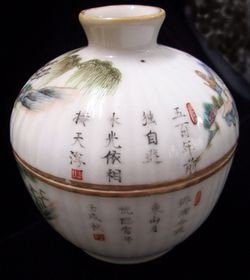Antique Porcelain Marks (page 2)
Private kilns:
The many types of antique porcelain marks from private kilns show that
private kilns were generally more open to free expression. Their content
shows more diverse information or traditional symbolic meanings
inherent to Chinese culture:
Apart from the marks containing the reign name, there is a wealth of
other marks with content that cannot be used for dating purposes.
However, the name of the shop or manufacturer is hardy usable for dating Chinese ceramics. Certain marks from
the the Ming and especially the Qing dynasties are frequently found on
later porcelain, made to order for court officials or persons of high rank.
Some antique porcelain marks identify the name of the buyer (or recipient), or did contain a dedication for the recipient when an item was a gift. However, all these cannot be used for dating ceramics.
Frequently auspicious characters, words or symbols, and a wide variety
of other content meaningful in the context of Chinese culture was
integrated in marks.
Quite clearly, the purpose of the antique porcelain marks and their
diverse usage was not in any manner similar to usage in Europe.
|
Towards the end of the Qing dynasty and during the republic period
ceramics were also increasingly signed or marked by the artists
decorating these.
|
 |
Export porcelain:
The majority of the porcelain made specifically for export did not have
any marks. Ceramics with marks were often not made specifically for
export but were added to a shipping batch anyway.
Systematic marking of export porcelain did not begin before the late
19th century. In the 1890s export porcelain was marked with "China" for
the first time, due to a new import regulation of the United States
requiring that the country of origin had to be stated on imported items.
Antique Porcelain Marks / Pottery Marks / Signed Porcelain
Porcelain marks were either hand-painted or written, impressed, stamped with a different color, or incised (scratched).
When we talk of a "seal mark" we may mean any of the following types:
- Hand-written (painted) in archaic characters, as used in seals
- Stamped (often in red) with seal ink
- Seal impressions (indented mark impression with base and mark the same color)
- Seal impressions (same as above, but seal/characters are elevated, protruding from level base. (How did they make these?)
This cannot be emphasized enough:
Don't get fixated on the marks when it comes to Chinese porcelain.
|
A lot if not most of Chinese porcelain was never marked in the first place. But of those ancient ceramics that have marks, these marks often do not show the actual period of manufacturing, but rather that of an earlier reign. Unlike with European porcelain, dating Chinese porcelain based on marks properly is often difficult and outright misleading. More on the problems of using antique marks present on antiques for identification. |
Today Chinese porcelain items with marks you may find or purchase are more likely fakes or newer items, than authentic antiques.
Probably the best example for this is the porcelain made during the late
Qing dynasty. In the Guangxu period huge amounts of porcelain China
were produced, and many of these bear different Kangxi reign marks.
In addition to this there are Qing dynasty marks that appear both in the
early days of the dynasty and again toward its end, but not in between.
Many porcelain pieces produced in the early republic period bear a
Qianlong reign mark.
This said, for the serious collector or dealer of porcelain a good reference book as source of antique porcelain marks is an indispensable requirement for identifying porcelain. If you read Chinese, you have an even better choice of mark books.
Selection of Chinese marks (private kiln marks)
Just to state the obvious again - marks are not reliable for dating. They can be and are faked, but even genuine marks can be unreliable:
See Note on Transplanting of Marks - faking methods

More about marks:
Exceptional reign marks
Antique China Marks - a comparison
Dated porcelain
............................................................................................................
Home › Porcelain Marks › Porcelain Marks (cont.) › Antique Marks (an overview)
